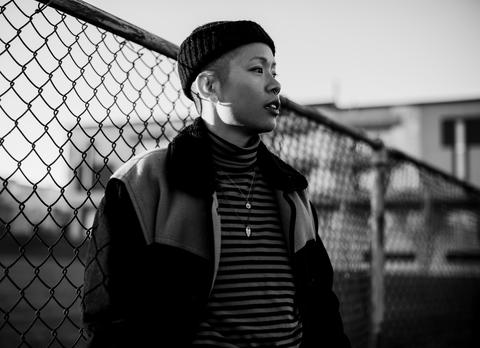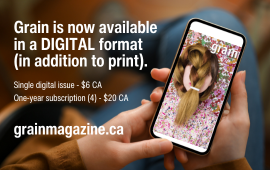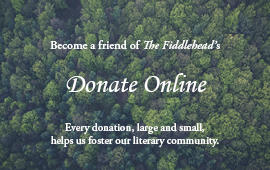
An interview with Creative Nonfiction Contest Winner K Ho by Melissa Spohr-Weiss:
Melissa Spohr-Weiss: First off, I want to congratulate you for winning The Fiddlehead’s 2021 Creative Nonfiction Contest with your essay, “Dispatches.” I’m fascinated by the way your writing seamlessly moves from fiction workshops to pop culture references, introspection to literary essays. I was particularly struck by the image of lonely whale 52 Blue, whose “song is different because it has a different body.” Can you speak about your research process? How did you decide which references to include in your essay?
K Ho: Thank you! There are many writers on the shortlist whose work I admire. I’m very honoured.
The research process is a good question. I’m not sure if I actively sought out research so much as the research naturally surfaced. I wrote the essay over eight months of the pandemic, while I was living off a graduate stipend and grappling with a mess of feelings about starting testosterone. The essay came to me when I was waiting in line at the public pool. I had asked the lifeguard a question when my voice cracked for the first time. As I stood in that line, slightly embarrassed, slightly excited, I thought of a conversation I’d had a friend about how writers define literary voice (we had no idea). I knew then that I wanted to braid my experience of a shifting, cracking voice with the concept of literary voice: voice in the body, voice on the page, and all the spaces between.
The moment I took out my notebook, fifteen or so memories rushed at me, all comprised of encounters I’d had with voice. Writing creative nonfiction is funny that way. I don’t always know an essay is building around me until I locate a central thread around which to organize my thoughts. Then, everything I’ve absorbed over the past months has a sudden purpose. For this essay, once I had that thread, the paragraphs appeared almost fully formed.
MSW: Who is your ideal audience for this piece?
KH: I rarely see myself reflected in the literary canon. In my work, I try to write toward self-recognition. I try to carve out something that feels alive and true to me. My hope is that my specific entry point can extend to and resonate with readers, especially other QTBIPOC. That’s what’s wonderful and daunting about writing: the task feels small and huge at once.
I think the pandemic has done an interesting thing of collectivizing our experiences of isolation, but also of deepening our relationship to ourselves. I’ve heard about so many folks finally being able to explore their gender identities in the quiet of their homes. My goal was to write about the life of a trans writer of colour, about emergence and consciousness and the living hours of change. So many white dudes get to do this. So many white women. We’re here too. We’re here now.
MSW: I’m always interested in the way form and content speak to one another. Your essay is presented as a series of short scenes – with imagery so richly layered it could perhaps even be considered a long poem. However, despite the continuous breaks in narration to move to the next scene, your essay always remains firmly rooted in voice. Would the piece look different if it was presented as a more traditional narrative essay? Why did you choose this fragmentary style?
KH: I think this essay would implode if I tried to fit it into a traditional structure. In CNF, I often struggle with how to apply narrative resolution to an experience when the experience itself is ongoing. It was especially challenging to write about my transition because, as I note somewhere in the essay, my gender has no destination. Working with fragmentation gave me the freedom to think and linger and go nowhere. I hope the gaps between paragraphs invite readers to become active participants in the text—to think and linger and go nowhere with me.
Looking back, I do have questions about how I used white space in certain section breaks, and if there were places where I needed to do more work. White space can be a useful tool for generative refusal, but I also wonder about the ethics of leaving something unspoken, especially when writing about communities outside of oneself. I’ve been thinking a lot about Trinh T. Minh-ha’s concept of speaking nearby, and I hope to continue learning and exploring these responsibilities throughout my work.
MSW: Can you list some of the writers whose voices resonate with you the most? Who inspires you?
KH: I recently read Terese Marie Mailhot’s Heart Berries for the third time. Her voice is self-possessed and intelligent and brutal. She inspires me to leap. Lara Mimosa Montes has a way of making grief and silence three-dimensional on the page. I don’t know how to explain it—it’s like an architecture of loss. I’m indebted to my friends mentioned in the essay, who are brilliant QTBIPOC artists and cultural workers, as well as Katie Miller and the good folks at the University of Guelph MFA, who helped me shape this piece. Lastly, Bahar Orang’s How Things Touch inspired my use of parentheses in the essay; she uses square brackets, which remind me of windows.
MSW: What was your thought-process behind the title?
KH: A dispatch is a message sent off to a receiver. To me, each paragraph of the essay, each stanza, operates as a brief sonic room—a dispatch of its own. The essay is the accumulation of these rooms arranged next to each other. You step inside, look around, listen a little, then take your leave. Maybe you’ll hear echoes between the walls.
Click here to read an excerpt from Dispatches
photo credit Joy Gyamfi











Add new comment